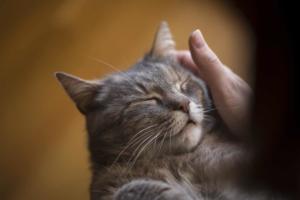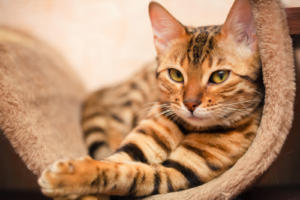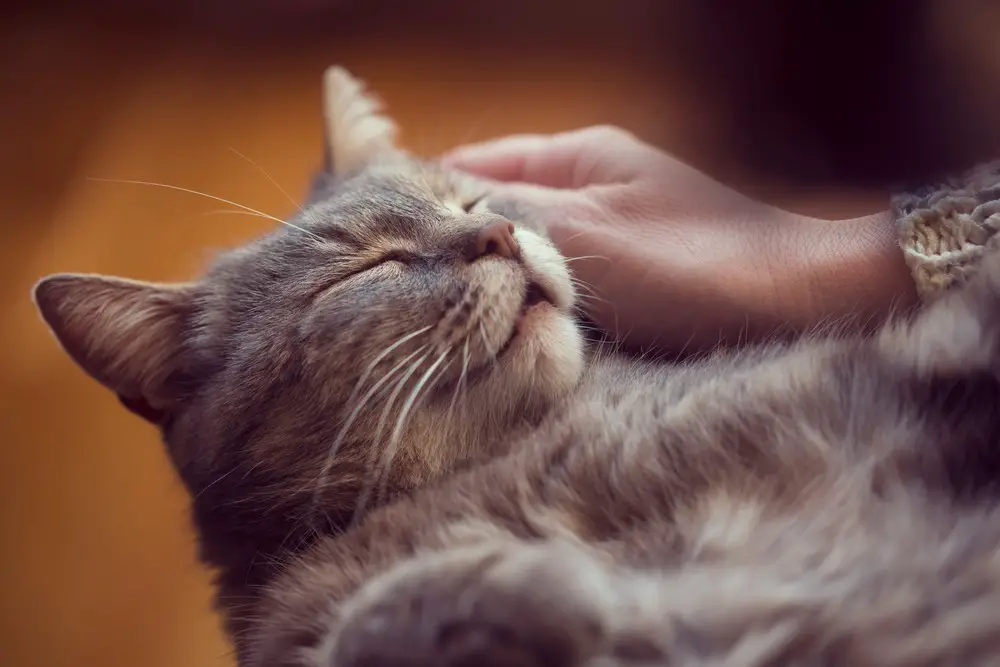As I sit here with our little long haired cat, Nipper, I can’t help but wonder why she is purring so much. I have had pet cats for a long as I can remember and I’ve found one of the most charming things about cats, other than their playful personalities, is their ability to ceaselessly cheer me up. One of the ways that cats do that, is through their beautiful purrs. But why do cats purr? Are they happy? How do they purr?
These questions are not new. Questioning the nature of the cat purr is something we have been thinking about for a long time as humans. The first studies go back to as early 1834, where a scientist named Dr. Owen investigated these questions that I am now asking myself almost 200 years later. Since then,these questions have not disappeared. Our little feline friends continue to confuse and amuse us.
Perhaps Lewis Carroll summed up the charming nature of cats and their purrs best in ‘Through the Looking Glass’, ‘It is a very inconvenient habit of kittens (Alice had once made the remark) that whatever you say to them, they always purr.’
For more cat facts, read here.
How does a cat purr?
The mechanics of the cat purr has been explored by many scientists. The process, by which cats purr, still has many mysteries. For example, scientists can’t agree on how cats start to purr. Some argue it is a voluntary and a cat’s choice to do so. Yet, others argue that it is due to a release of endorphins, caused by pleasure or pain, which will be discussed later in this article.
Kittens learn how to purr when they are a couple of days old. Veterinarians suggest that it is a way that kittens are able to communicate and bonds mother and child. Therefore, a kitten’s purr can be seen in a similar way to a baby’s coo, it is a primary communicatory function. Purring is a unique vocal feature in the domestic cat. Some other large cats do make similar noises such as bobcats, cheetahs and lions.
Yet, the purr is distinctive from other cat noises as it is produced during the respiratory cycle, through inhaling and exhaling. Other typical cat noises such as the ‘meow’ only occur when a cat exhales, whereas uniquely the purr occurs during the inhalation and exhalation cycle.
A cat purrs by first, sending an electrical message through their nervous system to the laryngeal muscles in the voice box. Once the message is received the voice box begins to vibrate. This muscle acts like a valve, which opens and closes allowing air to flow over the voice box.
The best way to imagine it is like a door caught in the wind, opening and closing due to continuous pressure from the wind, except in the cat’s case this pressure comes from their muscles. The vibrations then creates the purring sound that we know and love so much. There are an incredible 25 to 150 vibrations per second.
Scientists used to think that the purr was produced through blood moving through a defective (or small) vena cava, the main artery in the heart. However, further research shows that internal laryngeal muscles in the throat are used to make the sound whilst breathing.
However, not all cats can purr, for example if a cat has laryngeal paralysis, a cat will be unable to purr. The laryngeal muscles open and close the space between the vocal chords (called the glottis). As cats do this they separate their vocal chords which creates a purring sound.
Frazer-Sisson argues that the movement of these laryngeal muscles is signalled from a unique part of the cat’s brain called the neutral oscillator. This means that there is actually a part of the cat’s brain which is uniquely designed to deal with purring! The cat’s purr can be best understood as the cat inhaling and exhaling which creates a continuous cycle and the cat’s ability to purr continuously.

Why do cats purr? Cats seem to purr more when they are happy and relaxed
Do all cats purr?
Now that we know how cats purr it leads me to an important question, do all cats purr? Obviously, Nipper purrs, she is purring right now, but I have never heard a lion or tiger purr, not that I have gotten close enough to one. If I had been able to get in close proximity, I wouldn’t hear a purr. It has been shown that some cats simply can’t purr and in general it is the larger cats.
Before you start feeling sorry for these bigger cats, don’t worry too much, instead of a gentle purr they are capable of a powerful roar, something that smaller cats are not able to do. In fact, it is this distinction between a cat’s ability to purr or roar that splits the feline genus into two groups. The first is Felis, the purring group, which includes domestic catsand pumas among other cats.
On a side note, cats aren’t the only animals that create the purring sound. Racoons and guinea pigs have been observed to also ‘purr’, however this purr is more of an imitation and is distinctly different from a true purr of a cat. The second group of cats is the Panthera group, or roaring cats. These roaring cats can all be traced back to a split from the purring cat’s evolutionary tree around six million years ago.
One question still remains regarding which cats purr and which roar, what physically is different between the Felis and Panthera groups? This was the exact question that Dr. Owen asked back in 1834 and his results showed that roaring cats have extra cartilage in their throat.
This cartilage prevents the air from inhaling and exhaling to flow over the voice box, and thus prevents purring. However, this cartilage allows the big cats to fully extend their jaw allowing enough flexibility to produce a mighty roar.
Below is a video of Merlin the cat. He holds the world record for the loudest purring cat. I am not totally sure but I think Nipper can purr louder than this!
What reasons are there for cats purring? Does purring mean a cat is happy?
Why do cats purr? Nipper has just stretched her front legs out in the way that cats do, her claws fully extended as she shakes out any cramp that she had and stands up. She then does a full circle trying to find the perfect spot to settle down for maximum comfort for the next hour until he decides it appropriate to repeat the whole process.
As she finally settles down, giving a huge yawn to announce her intentions of sleep, she closes her eyes and begins to gently purr. It has got me thinking, she is obviously content, but is the purring a result of her happiness or another reason? What other reasons could cause a cat to purr other than being happy? Why do cats purr?
It turns out that one again scientists aren’t sure about what causes cats to purr. It is generally accepted that cats do purr when they are happy. Although this may not be the only reason, much in the same way that a person smiling doesn’t meant that they are happy.
In fact, veterinarian Kelly Morgan directly equates purring to smiling; ‘People will smile when they’re nervous, when they want something, and when they’re happy, so perhaps the purr can also be an appeasing gesture.’ However, this may not be the sole reason.
If purring is due to a release of endorphins, then they will purr then they experience pleasure but also pain. This is because it is the same chemicals which are released, this link between pleasure and pain is also deeply rooted within our own human biology.
Further research into this link unexpected link between purrs and pain has shown that purring could have potentially lifesaving benefits, not that I think Nipper is in much danger at the moment. The greatest danger she faces in his day to day life is the two-foot-high jump off the sofa to run to the kitchen for her food. However, before domestic cats were domesticated, they would have had much greater threats including the threat of predators.
Why do cats purr, to mask their kittens? Scientists have hypothesised that mother cats used loud purring to mask the meowling of her kittens. I don’t know about anyone else but kittens sure can make quite a lot of noise so it would have to be a very loud purr! None the less, there appears to be enough evidence that this theory hasn’t been discounted just yet.
This isn’t the only benefit of purring, there are positives that are more applicable to the modern domestic cat. The first is that purring may act as a sort of natural painkiller much in the same way that rubbing your head when you have banged it against the kitchen cupboard releases chemicals to soothe the pain, purring could have the same effect for cats.
This has been observed for cases of extreme pain such as when a mother cat is in labour and this mechanism would explain why cats appear to be programmed to purr as a response to pain.
Strangely, acting as a natural painkiller isn’t where the medical benefits end. The frequencies that cats purr at has been shown to help improve bone density, as well as repair muscles and tendons, ease breathing and reduce swelling. This means that purring is a way for cats to self-heal, perhaps there is something that we could learn from our feline friends, if only I could let loose a few good guttural growls to help get rid of this headache.
However, if anybody reading this happens to have been a cat owner, whether in the past or present they will know that cats are much more cunning than perhaps their evolutionary story suggests. Terr Pratchett once said that ‘cats will amusingly tolerate humans only until someone comes up with a tin opener that can be operated with a paw.’ Indeed, it has been shown that when a cat has a one to one relationship with a human, they learn to communicate with that specific human.
Even with this skills, non-cat owners still aren’t in the clear, the University of Sussex, one of the main hubs for modern day domestic cat research, has found that domestic cats purr’s have similar frequencies to that of a baby’s cry. This vibration in the 220 to 520 hertz range, not only irritates us humans but also appeals to our nurturing instincts with the ultimate result being that ‘cats apparently learn to do this to get people to feed them sooner’ according to veterinarian Benjamin L. Hart.
Which explains a lot as I have suspected Nipper, and her purr,to be getting cuter and cuter. Whereas in reality it turns out that she is merely getting more and more sneaky!
One of the most surprising reasons cats purr is because they use purring as a form of exercise! I have to say that this one makes me laugh, because as I look at Nipper curled up on my feet purring it seems unlikely to me that she is actually performing a form of low-key exercise!
However, according to Dr Leslie Lyons, a world-renowned genetics researcher at the University of Missouri College of Veterinary Medicine, the vibrations of purring may stimulate muscles and bones in a form of calisthenic exercise. I find that a truly crazy thought and am jealous of my cat’s ability to be able to engage in exercise whilst lying down and sleeping. I’ve got to say I wish I could learn a trick or two from it, it would definitely beat going to the gym!

- Cats will purr when they feel relaxed, happy and content.
Is purring good for humans as well?
Fear not! Just when you were thinking that cats were selfish manipulative animals who use their humans merely for food, don’t despair, there is a benefit for the owners also. The University of Minnesota spent ten years performing a study looking in the benefits of the cat’s purr.
They found that not only do owning cats relieve stress and lower blood pressure at a much better rate than owning other pets, they also reduce the chance heart attacks by 40 percent and purring plays a major role in this stat. Doctor Rebecca Johnson concluded ‘purring is an auditory stimulus that people attribute to peacefulness and calmness, that gives us positive reinforcement for what we’re doing and can contribute to the whole relaxation effect when we interact with our cats.’
What does the future hold for purr research?
With a rich history of research into the cat purr what does the future hold? Is anyone still interested in the cat purr? What could we possibly learn from the low hum of our feline friends? Unfortunately for us purr lovers, most research around cats is conducted on the larger, roaring kind but there still a few hubs of research for the domestic moggy. The main centre is the aforementioned University of Sussex, so there are people looking for further breakthroughs in the field.
One area that seems to be promising is the idea of self-healing, could purring be somehow transferred to the field of medicine? It certainly would be optimistic, but it wouldn’t be the first time that humanity has looked to nature for medical solutions.
There are a lot of questions and not many answers when thinking about the topic of what else we could learn about the purr, but I think it is an important topic that given it’s track record, deserves more attention than it is getting at the moment. As I type this last sentence, Nipper raises her head and gives me a lazy wink almost as if she is in agreeance although most likely she is just trying to determine if it is dinner time.
Conclusion
Why do cats purr? Overall, there are still many things we don’t know about how and why cats purr. However, I hope that this article began to start answering some of the questions you cat owners and cat enthusiasts had. The cat’s purr not only has healing properties but can be used to signal pain, a need for attention or as a way for kittens to let their mothers know that they are there.
In its primary form the purr is a function that cats have evolved, not just as a tool to communicate with each other but with us humans as well. Personally, I found the University of Sussex study on cat purrs being the same frequency as a baby’s cry fascinating, as it shows how our furry friends are evolving and adapting to fit into a more domesticated lifestyle.
Whilst domestic cats are not the only cats that purr, a domestic cat’s purr has many more functions. Hopefully, this article has given you a little taste into further apricating how incredible the beautiful animal is lying on your lap or sitting on your homework.
The truth being that the science of how a cat functions is still in its infancy, so it will be interesting to see how further studies from the University of Sussex and the University of Missouri affect our understanding of domestic cats. In the meantime, as Nipper purrs whilst gently batting my foot I can’t help but smile and wonder why she is purring.
If you enjoyed reading this article why not have a look at some of the other curious cat questions. You will find them in the right hand side bar.
Bye for now!
